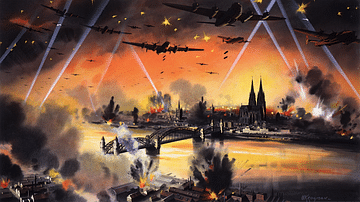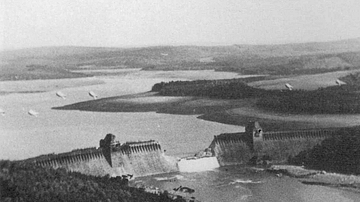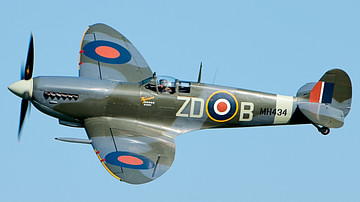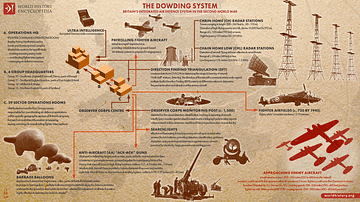
Britain's integrated air defence system in the Second World War (1939-45), known as the Dowding System after the air chief marshal of that name, included code-breakers, radar stations, observers, searchlights, barrage balloons, anti-aircraft guns, and fighter planes. Working together through a combined operations centre, these various elements ensured that the German Air Force could be better tracked and intercepted, and so, the Dowding System helped win the Battle of Britain.
Air Chief Marshal Hugh Dowding (1882-1970), commander-in-chief of RAF Fighter Command, had been determined to improve Britain's air defences in the interwar years, starting with the idea for a design competition for new fighter planes, the winners being the Hawker Hurricane and Supermarine Spitfire. In 1936, Dowding was appointed head of the RAF's Fighter Command. The position meant that Dowding controlled the operation of fighter planes, Anti-Aircraft Command (which operated flak guns and searchlights), Balloon Command (which handled anti-aircraft barrage balloons), a thousand units of early warning volunteer observers, and over 50 radar stations, a new technology Dowding had supported the development of. All of these elements would combine into what became popularly known as the Dowding System of air defence, which permitted the early detection and reception of enemy aircraft flying over Britain.
Integrated Defence
Britain's integrated air defence system (IADS) was created on 1 May 1936 after German aggression in Europe first became evident with the reoccupation of the Rhineland in March that year. The idea of pooling resources for air defence went back to the First World War (1914-18) when Germany had bombed Britain using such aircraft as Zeppelin airships. The Air Defence of Great Britain (ADGB) had lapsed in the 1920s but was now revived and expanded. The Dowding System eventually consisted of seven parts:
- the fighter plane squadrons of RAF Fighter Command
- the anti-aircraft artillery of Anti-Aircraft Command
- the searchlights of the Royal Engineers
- the lookouts of the Royal Observer Corps
- static barrage balloons to deter air attacks on important sites
- static and mobile radar stations
- Ultra military intelligence

The first IADS covered southern England, the north and west of England, and Scotland. Volunteers of the Observer Corps scanned the skies for enemy planes and reported sightings by telephone to a local reporting centre, which in turn contacted the Operations Centre Head Quarters. Spotters at the sites with AA artillery and searchlight units did the same. With Britain's airspace divided into a massive grid, plotters at HQ could track home and enemy aircraft, making updates every five minutes. This was all well and good, but there were two fundamental weaknesses in the system. The first was that enemy aircraft would only be spotted as they approached the coast where the Observer Corps was positioned. The second was that in cloudy weather or at night, enemy planes would be able to enter Britain's air space unobserved. These problems now seemed very important to solve quickly. Britain had declared war on Germany in September 1939 following the latter's invasion of Poland. By 1940, Germany had marched through the Low Countries, British forces had abandoned the Continent in the Dunkirk evacuation, and France had fallen. A German invasion of Britain (Operation Sea Lion) looked imminent, and it would surely be preceded by the Luftwaffe (German Air Force) attacking Britain's airfields and strategically important industries as it tried to gain air superiority. Fortunately for Britain, technology came to the rescue with a new and highly secret 'weapon' that proved decisive in the coming air battle, the Battle of Britain, officially dated as 10 July to 31 October 1940 by the Air Ministry.
Radar Stations
The solution to creating a genuine early warning system for air attacks was RADAR: Radio Detection and Ranging. Germany had its own version of radar, as did several other countries. Britain's version, known as Radio Direction Finding (RDF), was pioneered by Robert Watson-Watt (1892-1973) with research and development funded by the Air Ministry. The system could (more or less) detect the position and height of incoming aircraft and, by plotting multiple readings and cross-references from other radar stations, their general direction. The technology was crucial to defend Britain from air attacks that might come anywhere at any time, as explained by Wing Commander 'Max' Aitken:
We had the biggest asset any Air Force ever had, which was radar. Radar really won the Battle of Britain because without it we would have been doing standing patrols and with the limited number of aircraft and limited number of pilots you couldn't have done it.
(Holmes, 134)
The radar system, tested from March 1936, consisted of groups of 350-foot (107-metre) tall steel towers between which were suspended several wire transmission aerials. The wires sent out signals over a 100-degree arc, which would be interrupted by enemy aircraft, sending back 'electronic echoes' to receiver towers. This type of radar was known as AMES Type 1. There was a more sophisticated alternative, the AMES Type 2, which used shorter towers and, instead of suspended wires, two rotating aerials to send out signals. Type 2s were developed by the Royal Navy to monitor ships, and although they had a shorter range than Type 1, they could send a signal 360 degrees and better determine a target's position. Radar towers were swiftly built along the southern and southeast coast of England, with some located inland, too. A Type 1 radar tower could detect enemy aircraft from 60-100 miles (100-160 km) away. The network of Type 1 towers was called Chain Home (CH) while Type 2 was called Chain Home Low (CHL) since it helped find aircraft flying below 1,000 feet (300 m). By the summer of 1940, Britain had 20 CH stations and 30 CHL stations. In anticipation that the enemy would try and destroy the radar towers, 24 mobile units were created, known as MB2s, which could be moved anywhere to replace a damaged station. Groups of towers sent back signals to a station which then communicated (via underground telephone lines) to the brain of the entire system: RAF Fighter Command's Operations Room HQ.
Although radar towers were an obvious target for Luftwaffe dive bombers, they proved remarkably resilient and relatively easy to repair. From 1941, night fighter planes equipped with radar added to Fighter Command's abilities to track enemy aircraft. Yet another source of information in the Dowding System was RAF's Coastal Command, which conducted reconnaissance flights over the English Channel, North Sea, and the ports of northern Europe.
Observer Corps
Additional information came to Fighter Command from the Observer Corps, which had been formally created in 1929 and which, by 1940, was under the command of Air Commodore Alfred Warrington-Morris (1883-1962). The Observer Corps had over 30,000 volunteers spread over 1,000 lookout posts (which increased to 1,500 by 1944). Each post was manned 24 hours a day and contained binoculars, an altitude estimator (a sextant-like instrument), a grid map, a telephone, and, naturally, tea-making facilities. Observers communicated sightings to a Group Centre, which then linked to the local fighter defence centre. When Germany sent over unmanned V-1 rockets towards the end of the war, observers fired flares to help fighters intercept them.
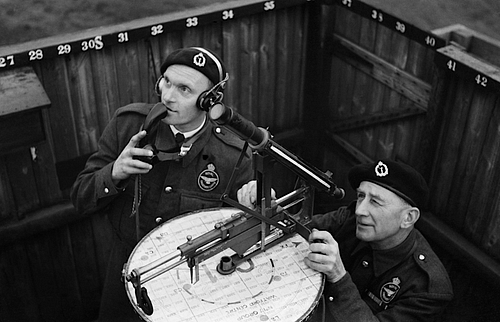
The public helped with observation in the Dowding System, especially after the RAF began running aircraft-spotting courses around Britain. There was even a specific book published by Penguin, Aircraft Recognition, although differentiating between enemy and home aircraft was not easy.
Ultra Intelligence
There was another, highly secret source of information, called Ultra intelligence, from 'ultra secret'. This was Britain's ability to decode German communications using, amongst others, the Enigma cipher machine which specialist codebreakers like Alan Turing (1912-54) at Bletchley Park (near London) learnt the secrets of. This was a breakthrough unknown to the enemy, who remained confident the Enigma machines were unbreakable (the French and Poles also broke the code). Each key of the Enigma machine could produce millions of coded variations, but to the delight of cryptographers, the system had the inherent weakness of not having any number keys to increase variation. Additional aids to the code-breakers were the occasional capture of code lists (which changed regularly) and operators not always abiding by strict security procedures. The RAF listening station at Cheadle was another useful source of intelligence since operators there could intercept radio chatter between Luftwaffe pilots.
Operations HQ
Fighter Command's headquarters was a bomb-proof underground complex at Bentley Priory. Here the Filter Room received information from all the sources mentioned above and passed on relevant data to 'plotters', members of the Women's Auxiliary Air Force (WAAF), who marked the progress of enemy aircraft and the deployment of RAF fighter squadrons on a giant map known as the General Situation Map (GSM) in the HQ Operations Room. HQ passed on to each fighter Group Head Quarters updates which would in turn be communicated with sector stations that spoke by radio to the actual airfields telling the fighters when to take off and where to go. The airborne RAF planes were then tracked using Radio-Telephony Direction Finding (R/T-D/F).
Air Raid Precaution (ARP) units were warned by Fighter Command so that air raid sirens could be set off to warn civilians. Fighter Command sent telephone messages to control centres, which then relayed on to any number of the 111 warning districts that Britain had been divided into. Colour-coded warnings indicated the proximity of the enemy aircraft. A yellow warning meant that aircraft were 22 minutes away. A purple warning meant that enemy aircraft were expected to fly over but not attack a certain area – such an area had to black out all exterior lighting. A red warning meant the aircraft were just 12 minutes away and resulted in the local police sounding the air-raid sirens. In response to the sirens, the public was expected to take shelter in their cellars, Anderson shelters in their gardens, or community shelters like underground stations. A green message meant the aircraft had passed over, a situation communicated to the public by a siren ringing on a steady note.
Anti-Aircraft Guns
Anti-aircraft artillery (AA) guns, or Ack-Ack guns as they were called because of their distinctive repetitive noise, were operated by Anti-Aircraft Command, established in April 1939 and led by Lieutenant-General Frederick Pile (1884-1976). Initially, the AA units were set up to defend airfields and factories during the Battle of Britain. After the attacks on cities, AA guns were added to city defences. Light AA guns, useful only against low-flying aircraft, fired 1.4-1.6-inch (37-40 mm) shells. Heavy AA guns fired 3.7-inch (9.4 cm) calibre shells at a rate of ten rounds per minute. Some newer guns had a calibre of 4.5 inches (11.4 cm). The shells were effective up to a height of 25,000 feet (7,600 m). The shells exploded when set off by a timer, sending shrapnel in a radius of 45 feet (13.7 m). To concentrate fire, AA guns were usually grouped into a battery of four, six, or eight.
AA units were alerted to enemy aircraft in their sector by Fighter Command HQ. Unfortunately for the defence of Britain, the number of AA units was remarkably few, given the territory to be protected. "By June 1940 there were 1,204 heavy and 581 light anti-aircraft guns" (Overy, 43). Hitting fast-moving enemy planes at night (or even during the day) was often beyond the capabilities of the gun technology of 1940. As a result, "in September 30,000 shells were fired for every enemy plane destroyed" (Ziegler, 117). Crews did get better with practice and with the addition of radar assistance so that by the next year, 4,000 shells were required per 'hit'. The guns did push aircraft to fly at a higher altitude and boosted local morale that something active was being done in terms of defence.
Searchlights
Searchlights were set near the AA batteries in the hope that their beams would highlight the position of aircraft to help the gunners aim. A typical searchlight during the Battle of Britain had a 36-inch (90 cm) beam with 210 million candlepower that was effective up to 12,000 feet (3,660 m). In the latter stages of 1940, 60-inch (150 cm) searchlights were being used, which had more than double the power. Another development was to give searchlights a radar capability. Searchlights could be used to help guide damaged RAF bombers back to their bases or to land safely. This was done by having a section of lights all shine their beams vertically and then move horizontally in the direction of the landing area. Around 3,000 bomber planes were helped home by this method during the war.
Anti-aircraft units and searchlight teams also communicated back to Fighter Command with sightings, particularly the speed, direction, and strength of an incoming or outgoing enemy force.
Barrage Balloons
Barrage balloons, made by companies such as the tyre manufacturer Dunlop, were static defences winched up into the air over cities, docks, and industrial targets in the hope that low-flying aircraft would become entangled in the metal wires which then released parachutes that caused the aircraft to stall its engines. Barrage balloons could be tethered to a height of 5,000 feet (1,500 m). They were typically operated by members of the WAAF. Like the anti-aircraft guns, balloons struggled to cause direct casualties (in the entire war they only accounted for 30 planes), but they did make aircraft fly higher, and so bombing accuracy was decreased. London had around 1,000 barrage balloons in 1940, first silver and then painted green. Balloons were effective against the V-1 rockets fired against Britain towards the end of the war, accounting for the destruction of 231 of them. Local communities often gave their nearest balloon a nickname like "Bishop of London", and the general name of these silent but ubiquitous defenders was 'pigs'.
The Fighters
After losses of men and aircraft during the Dunkirk evacuation, Fighter Command only had around 500 operational fighter planes. By August 1940, this figure had risen to over 1,000 operational aircraft which meant around 600 to 750 fighters could be put in the air (although Dowding rarely committed more than half of his force at any one time). The Luftwaffe had around the same number of fighters.
The RAF, thanks to excellent production rates, could replace its losses better than the Luftwaffe, which was operating from occupied territory and so could not replace lost planes as efficiently. The Luftwaffe had the advantage that the vast majority of its aircraft could be concentrated in the southeast of England. The RAF had to station fighters all over Britain, but it had the advantage of home ground, which meant fighters had more fuel and more time in the air than the enemy. Both sides struggled to replace lost pilots. The Battle of Britain would be finely balanced throughout.
The Dowding System provided a well-coordinated defence, but there still remained two fundamental problems: German fighters could cross the Channel in just six minutes and bombers could attack any target they pleased. Speed was everything, then, in organising an effective response.
Two of Dowding's four group commanders were Keith Park (1892-1975) and Trafford Leigh-Mallory (1892-1944). Park, famous for regularly flying himself to his airfields in a Hurricane, commanded No. 11 Fighter Group, the sector that protected southern England and was most often engaged with the Luftwaffe. Leigh-Mallory commanded the No. 12 Fighter Group protecting the industries of the Midlands. There was friction between the two commanders since Park wanted Leigh-Mallory to protect the southern airfields while his fighters were in battle. Leigh-Mallory preferred to send his fighters on the offensive against any targets they could find. Another controversy was Leigh-Mallory's support for Wing Commander Douglas Bader's idea of a 'Big Wing', a strategy not favoured by Dowding. The 'Big Wing' idea involved assembling several squadrons together in the air before attacking the enemy. The blow a 'Big Wing' could produce was much greater than that of scrambling a single squadron, but it took time to assemble the formation, and so, typically, enemy bombers had already hit their targets before the fighters got to them.
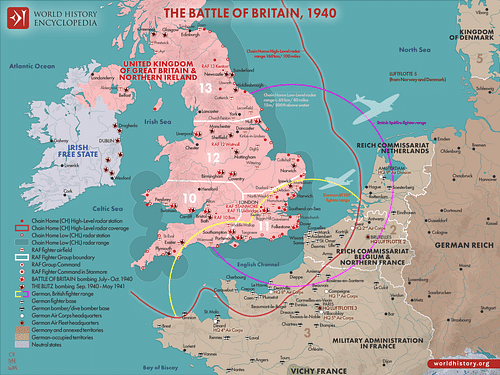
In September, the Luftwaffe changed tactics and began bombing London in what became known as the London Blitz, Dowding now gained much-needed time to replenish his fighter defences. The Battle of Britain, one of attrition, had been won. The RAF's total aircraft losses were around 788, compared to the Luftwaffe's 1,294 (Dear, 127). Dowding was awarded the Knight Grand Cross of the Order of the Bath for masterminding the successful defence of Britain. As Dowding's assistant Robert Wright noted, "He said he knew full well he could never win the war but he was very conscious of the fact that he was the one man who could easily lose it" (Holmes, 132).
Germany continued to bomb Britain throughout the war, albeit on a much smaller scale than the Blitz of 1940-41, which so badly battered London, Coventry, Plymouth, Cardiff, and many other cities across Britain. The Dowding System, although far from infallible, continued to aid the country's defences long after the Air Chief Marshal had moved on to other roles such as promoting relations with the United States. As Winston Churchill noted, the Dowding System "had been shaped and refined in constant action, and all was now fused together into a most elaborate instrument of war, the like of which existed nowhere else in the world" (Saunders, 38).






